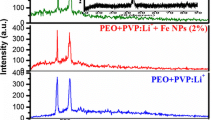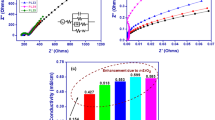Abstract
Development of solid polymer electrolyte (SPE) with rational ionic conductivity and mechanical stability for high-temperature solid-state lithium-ion batteries is still challenging. Herein, advanced semi-interpenetrating polymer networks (semi-IPNs) based on poly(ethylene oxide) (PEO)/polyvinyl alcohol (PVA)/graphene oxide (GO) nanoplatelets/lithium perchlorate salt (LiClO4) were prepared using solution-casting approach. The effects of PVA, LiClO4, and GO content variables on the ionic conductivity (IC), Young’s modulus (YM), tensile strength (TS) and elongation-at-break (ELB) of the prepared solid polymer electrolytes (SPEs) were investigated using response surface methodology (RSM). Considering R2 values above 94%, it was found that tensile strength and elongation-at-break decreased by increasing LiClO4 and GO contents, respectively. The DSC results demonstrated that GO nanoplatelets could act as nucleating agents and improve crystallinity. SEM micrographs showed a change in surface morphology due to crosslinking of PVA, which was accompanied by loss of spherulites. In addition, morphological change of the samples and formation of aggregations due to incorporation of nanoparticles was detected. The remarkable ionic conductivity of 1.65 × 10–3 S/cm was obtained for the sample with 30% (by weight) of PVA, 0.6 phr GO, and 12 phr LiClO4. These observations indicated that the prepared solid polymer electrolyte nanocomposites could be used in solid Li-ion batteries with good ionic conductivity and mechanical stability.
Graphical abstract








Similar content being viewed by others
Data availability
The data that support the findings of this study are available from the corresponding author, Ismaeil Ghasemi, upon reasonable request.
References
Scrosati B, Vincent CA (2000) Polymer electrolytes: the key to lithium polymer batteries. MRS Bull 25:28–30. https://doi.org/10.1557/mrs2000.15
Noor NAM, Isa MIN (2019) Investigation on transport and thermal studies of solid polymer electrolyte based on carboxymethyl cellulose doped ammonium thiocyanate for potential application in electrochemical devices. Int J Hydrogen Energy 44:8298–8306. https://doi.org/10.1016/j.ijhydene.2019.02.062
Yao P, Yu H, Ding Z, Liu Y, Lu J, Lavorgna M, Wu J, Liu X (2019) Review on polymer-based composite electrolytes for lithium batteries. Front Chem 7:522. https://doi.org/10.3389/fchem.2019.00522
Gomari S, Ghasemi I, Esfandeh M (2017) Functionalized graphene nanoplatelets/poly(ethylene oxide) nanocomposites: correlation between crystallization behavior and mechanical performance. Fibers Polym 18:2153–2160. https://doi.org/10.1007/s12221-017-6944-y
Johari SNAM (2021) A review: ionic conductivity of solid polymer electrolyte based polyethylene oxide. Int J Electrochem Sci 16:211049. https://doi.org/10.20964/2021.10.53
Feng J, Wang L, Chen Y, Wang P, Zhang H, He X (2021) PEO based polymer-ceramic hybrid solid electrolytes: a review. Nano Converg 8:2. https://doi.org/10.1186/s40580-020-00252-5
Volel M, Armand M, Gorecki W (2004) Influence of sample history on the morphology and transport properties of PEO-lithium salt complexes. Macromolecules 37:8373–8380. https://doi.org/10.1021/ma0490404
Gomari S, Esfandeh M, Ghasemi I (2017) All-solid-state flexible nanocomposite polymer electrolytes based on poly(ethylene oxide): lithium perchlorate using functionalized graphene. Solid State Ionics 303:37–46. https://doi.org/10.1016/j.ssi.2017.02.005
Gomari S, Ghasemi I, Esfandeh M (2016) Effect of polyethylene glycol-grafted graphene on the non-isothermal crystallization kinetics of poly(ethylene oxide) and poly(ethylene oxide):lithium perchlorate electrolyte systems. Mater Res Bull 83:24–34. https://doi.org/10.1016/j.materresbull.2016.05.021
Zhu L, Li J, Jia Y, Zhu P, Jing M, Yao S, Shen X, Li S, Tu F (2020) Toward high performance solid-state lithium-ion battery with a promising PEO/PPC blend solid polymer electrolyte. Int J Energy Res 44:10168–10178. https://doi.org/10.1002/er.5632
Wu Z, Xie Z, Wang J, Yu T, Du X, Wang Z, Hao X, Abudula A, Guan G (2020) Simultaneously enhancing the thermal stability and electrochemical performance of solid polymer electrolytes by incorporating rod-like Zn2(OH)BO3 particles. Int J Hydrogen Energy 45:19601–19610. https://doi.org/10.1016/j.ijhydene.2020.05.086
Das S, Ghosh A (2015) Effect of plasticizers on ionic conductivity and dielectric relaxation of PEO-LiClO4 polymer electrolyte. Electrochim Acta 171:59–65. https://doi.org/10.1016/j.electacta.2015.04.178
Young WS, Albert JNL, Schantz AB, Epps TH (2011) Mixed-salt effects on the ionic conductivity of lithium-doped PEO-containing block copolymers. Macromolecules 44:8116–8123. https://doi.org/10.1021/ma2013157
Itoh T (2002) Effect of branching in base polymer on ionic conductivity in hyperbranched polymer electrolytes. Solid State Ionics 150:337–345. https://doi.org/10.1016/S0167-2738(02)00535-0
Dhatarwal P, Sengwa RJ (2020) Dielectric relaxation, Li-ion transport, electrochemical, and structural behaviour of PEO/PVDF/LiClO4/TiO2/PC-based plasticized nanocomposite solid polymer electrolyte films. Compos Commun 17:182–191. https://doi.org/10.1016/j.coco.2019.12.006
Dias FB, Plomp L, Veldhuis JBJ (2000) Trends in polymer electrolytes for secondary lithium batteries. J Power Sources 88:169–191. https://doi.org/10.1016/S0378-7753(99)00529-7
Keyvan Rad J, Alinejad Z, Khoei S (2019) Controlled release and photothermal behavior of multipurpose nanocomposite particles containing encapsulated gold-decorated magnetite and 5-FU in poly (lactide-co-glycolide). ACS Biomater Sci Eng 5:4425–4434. https://doi.org/10.1021/acsbiomaterials.9b00790
Li J, Wong PS, Kim JK (2008) Hybrid nanocomposites containing carbon nanotubes and graphite nanoplatelets. Mater Sci Eng A 483–484:660–663. https://doi.org/10.1016/j.msea.2006.08.145
Keyvan Rad J, Ghomi AR, Mahdavian AR (2022) Preparation of photoswitchable polyacrylic nanocomposite fibers containing Au nanorods and spiropyran: optical and plasmonic properties. Langmuir 38:8428–8441. https://doi.org/10.1021/acs.langmuir.2c01041
Yuan M, Erdman J, Tang C, Ardebili H (2014) High performance solid polymer electrolyte with graphene oxide nanosheets. RSC Adv 4:59637–59642. https://doi.org/10.1039/C4RA07919A
Shafiei M, Ghasemi I, Gomari S, Abedini A, Jamjah R (2021) Positive temperature coefficient and electrical conductivity investigation of hybrid nanocomposites based on high-density polyethylene/graphene nanoplatelets/carbon black. Phys Status Solidi 218:2100361. https://doi.org/10.1002/pssa.202100361
Gahlot S, Kulshrestha V (2020) Graphene based polymer electrolyte membranes for electro-chemical energy applications. Int J Hydrogen Energy 45:17029–17056. https://doi.org/10.1016/j.ijhydene.2019.06.047
Elmér AM, Jannasch P (2006) Solid electrolyte membranes from semi-interpenetrating polymer networks of PEG-grafted polymethacrylates and poly(methyl methacrylate). Solid State Ionics 177:573–579. https://doi.org/10.1016/j.ssi.2005.12.021
Zeng Q, Lu Y, Chen P, Li Z, Wen X, Wen W, Liu Y, Zhang S, Zhao H, Zhou H, Wang ZX (2022) Semi-interpenetrating-network all-solid-state polymer electrolyte with liquid crystal constructing efficient ion transport channels for flexible solid lithium-metal batteries. J Energy Chem 67:157–167. https://doi.org/10.1016/j.jechem.2021.09.040
Baker MI, Walsh SP, Schwartz Z, Boyan BD (2012) A review of polyvinyl alcohol and its uses in cartilage and orthopedic applications. J Biomed Mater Res Part B Appl Biomater 100:1451–1457. https://doi.org/10.1002/jbm.b.32694
Chatterjee B, Kulshrestha N, Gupta PN (2016) Nano composite solid polymer electrolytes based on biodegradable polymers starch and poly vinyl alcohol. Measurement 82:490–499. https://doi.org/10.1016/j.measurement.2016.01.022
Bolto B, Tran T, Hoang M, Xie Z (2009) Crosslinked poly(vinyl alcohol) membranes. Prog Polym Sci 34:969–9681. https://doi.org/10.1016/j.progpolymsci.2009.05.003
Suk J, Lee YH, Kim DW, Cho SY, Kim JM, Kang YS (2016) Semi-interpenetrating solid polymer electrolyte based on thiol-ene cross-linker for all-solid-state lithium batteries. J Power Sources 334:154–161. https://doi.org/10.1016/j.jpowsour.2016.10.008
Sunitha VR, Kabbur SK, Pavan GS, Sandesh N, Suhas MR, Lalithnarayan C, Laxman N, Radhakrishnan S (2020) Lithium ion conduction in PVA-based polymer electrolyte system modified with combination of nanofillers. Ionics 26:823–829. https://doi.org/10.1007/s11581-019-03225-9
Jinisha B, Anilkumar KM, Manoj M, Pradeep VS, Jayalekshmi SJ (2017) Development of a novel type of solid polymer electrolyte for solid state lithium battery applications based on lithium enriched poly (ethylene oxide) (PEO)/poly(vinyl pyrrolidone) (PVP) blend polymer. Electrochim Acta 235:210–222. https://doi.org/10.1016/j.electacta.2017.03.118
Koduru HK, Scarpelli F, Marinov YG, Hadjichristov GB, Rafailov PM, Miloushev IK, Petrov AG, Godbert N, Bruno L, Scaramuzza N (2018) Characterization of PEO/PVP/GO nanocomposite solid polymer electrolyte membranes: microstructural, thermo-mechanical, and conductivity properties. Ionics 24:3459–3473. https://doi.org/10.1007/s11581-018-2484-8
Rahman N, Khan S (2018) Experimental design approach in the optimization of potentiometric method for lansoprazole determination using lansoprazole-tungstate based ion-selective electrode.Ind Eng Chem Res 57:9351–9361 Doi: https://doi.org/10.1021/acs.iecr.8b01281
Cho E, Park JS, Sekhon SS, Park GG, Yang TH, Lee WY, Kim CS, Park SB (2009) A study on proton conductivity of composite membranes with various ionic liquids for high-temperature anhydrous fuel cells. J Electrochem Soc 156:B197. https://doi.org/10.1149/1.3031406
Bezerra MA, Santelli RE, Oliveira EP, Villar LS, Escaleira LA (2008) Response surface methodology (RSM) as a tool for optimization in analytical chemistry. Talanta 76:965–9677. https://doi.org/10.1016/j.talanta.2008.05.019
Shen X, Peng L, Li R, Li H, Wang X, Huang B, Wu D, Zhang P, Zhao J (2019) Semi-interpenetrating network-structured single-ion conduction polymer electrolyte for lithium-ion batteries. Chem Electro Chem 6:4483–4490. https://doi.org/10.1002/celc.201901045
Zhou D, Shanmukaraj D, Tkacheva A, Armand M, Wang G (2019) Polymer electrolytes for lithium-based batteries: advances and prospects. Chem 5:2326–2352. https://doi.org/10.1016/j.chempr.2019.05.009
Lee JY, Yu TY, Chung PH, Lee WY, Yeh SC, Wu NL, Jeng RJ (2021) Semi-interpenetrating polymer network electrolytes based on a spiro-twisted benzoxazine for all-solid-state lithium-ion batteries. ACS Appl Energy Mater 4:2663–2671. https://doi.org/10.1021/acsaem.0c03222
Tanpichai S, Oksman K (2018) Crosslinked poly(vinyl alcohol) composite films with cellulose nanocrystals: mechanical and thermal properties. J Appl Polym Sci 135:45710. https://doi.org/10.1002/app.45710
Du X, Zhang H, Yuan Y, Wang Z (2021) Semi-interpenetrating network anion exchange membranes based on quaternized polyvinyl alcohol/poly(diallyldimethylammonium chloride). Green Energy Environ 6:743–750. https://doi.org/10.1016/j.gee.2020.06.015
Cong B, Song Y, Ren N, Xie G, Tao C, Huang Y, Xu G, Bao J (2018) Polyethylene glycol-based waterborne polyurethane as solid polymer electrolyte for all-solid-state lithium ion batteries. Mater Des 142:221–228. https://doi.org/10.1016/j.matdes.2018.01.039
Klongkan S, Pumchusak J (2015) Effects of the addition of LiCF3SO3 salt on the conductivity, thermal and mechanical properties of PEO-LiCF3SO3 solid polymer electrolyte. Int J Chem Eng Appl 6:165–168. https://doi.org/10.7763/IJCEA.2015.V6.474
Ghasemi FA, Niyaraki MN, Ghasemi I, Daneshpayeh S (2021) Predicting the tensile strength and elongation at break of PP/graphene/glass fiber/EPDM nanocomposites using response surface methodology. Mech Adv Mater Struct 28:981–989. https://doi.org/10.1080/15376494.2019.1614702
Nawaz K, Ayub M, Ul-Haq N, Khan MB, Khan Niazi MB, Hussain A (2016) The effect of large area graphene oxide (LAGO) nanosheets on the mechanical properties of polyvinyl alcohol. J Polym Eng 36:399–405. https://doi.org/10.1515/polyeng-2015-0271
Aram E, Ehsani M, Khonakdar HA, Abdollahi S (2019) Improvement of electrical, thermal, and mechanical properties of poly(methyl methacrylate)/poly(ethylene oxide) blend using graphene nanosheets. J Thermoplast Compos Mater 32:1176–1189. https://doi.org/10.1177/0892705718794776
Nimah YL, Muhaiminah ZH, Suprapto S (2021) Increase of solid polymer electrolyte ionic conductivity using nano-SiO2 synthesized from sugarcane bagasse as filler. Polymers 13:4240. https://doi.org/10.3390/polym13234240
Aparicio-Collado JL, Novoa JJ, Molina-Mateo J, Torregrosa-Cabanilles C, Serrano-Aroca Á, Sabateri Serra R (2020) Novel semi-interpenetrated polymer networks of poly (3-hydroxybutyrate-co-3-hydroxyvalerate)/poly (vinyl alcohol) with incorporated conductive polypyrrole nanoparticles. Polymers 13:57. https://doi.org/10.3390/polym13010057
Abu-Thabit N, Hakeem AS, Mezghani K, Ratemi E, Elzagheid M, Umar Y, Primartomo A, Al Batty S, Azad AK, Al Anazi S, Ahmad A (2020) Preparation of pH-Indicative and flame-retardant nanocomposite films for smart packaging applications. Sensors 20:5462. https://doi.org/10.3390/s20195462
Hou X, Siow KS (2001) Novel interpenetrating polymer network electrolytes. Polymer 42:4181–4188. https://doi.org/10.1016/S0032-3861(00)00818-1
Zeng Q, Wang Y, Wang Y, Cao W, Liu C, Shen C (2019) Polyethylene oxide-assisted dispersion of graphene nanoplatelets in poly(lactic acid) with enhanced mechanical properties and crystallization ability. Polym Test 78:106008. https://doi.org/10.1016/j.polymertesting.2019.106008
Wen X, Su Y, Li S, Ju W, Wang D (2021) Isothermal crystallization kinetics of poly (ethylene oxide)/poly (ethylene glycol)-g-silica nanocomposites. Polymers 13:648. https://doi.org/10.3390/polym13040648
Motahari F, Raisi A (2021) Reducing the crystallinity of high molecular weight poly (ethylene oxide) using ultraviolet cross-linking for preparation of gas separation membranes. J Appl Polym Sci 138:50059. https://doi.org/10.1002/app.50059
Author information
Authors and Affiliations
Corresponding author
Rights and permissions
Springer Nature or its licensor (e.g. a society or other partner) holds exclusive rights to this article under a publishing agreement with the author(s) or other rightsholder(s); author self-archiving of the accepted manuscript version of this article is solely governed by the terms of such publishing agreement and applicable law.
About this article
Cite this article
Hasanpoor, S., Ghasemi, I. & Gomari, S. Ionic conductivity and mechanical properties of semi-interpenetrating networks based on poly(ethylene oxide)/polyvinyl alcohol/graphene oxide: a response surface methodology study. Iran Polym J 33, 567–579 (2024). https://doi.org/10.1007/s13726-023-01269-3
Received:
Accepted:
Published:
Issue Date:
DOI: https://doi.org/10.1007/s13726-023-01269-3




